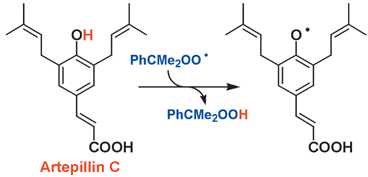Efficient radical scavenging ability of artepillin C, a major component of Brazilian propolis, and the mechanism
Abstract
Hydrogen transfer from artepillin C to cumylperoxyl radical proceeds via one-step hydrogen atom transfer rather than via

* Corresponding authors
a
Redox Regulation Research Group, Research Center for Radiation Safety, National Institute of Radiological Sciences, Inage-ku, Chiba 263-8555, Japan
E-mail:
nakanis@nirs.go.jp
Fax: +81-43-255-6819
Tel: +81-43-206-3131
b
Department of Material and Life Science, Graduate School of Engineering, Osaka University, CREST, Japan Science and Technology Corporation, Suita, Osaka 565-0871, Japan
E-mail:
fukuzumi@chem.eng.osaka-u.ac.jp
Fax: +81-6-6879-7370
Tel: +81-6-6879-7368
c Department of Biological Science & Technology, Faculty of Engineering, The University of Tokushima, 2-1 Minamijosanjima-cho, Tokushima 770-8506, Japan
d Division of Organic Chemistry, National Institute of Health Sciences, Setagaya-ku, Tokyo 158-8501, Japan
e Department of Applied Chemistry, Shibaura Institute of Technology, Minato-ku, Tokyo 108-8548, Japan
Hydrogen transfer from artepillin C to cumylperoxyl radical proceeds via one-step hydrogen atom transfer rather than via

 Please wait while we load your content...
Something went wrong. Try again?
Please wait while we load your content...
Something went wrong. Try again?
I. Nakanishi, Y. Uto, K. Ohkubo, K. Miyazaki, H. Yakumaru, S. Urano, H. Okuda, J. Ueda, T. Ozawa, K. Fukuhara, S. Fukuzumi, H. Nagasawa, H. Hori and N. Ikota, Org. Biomol. Chem., 2003, 1, 1452 DOI: 10.1039/B302098C
To request permission to reproduce material from this article, please go to the Copyright Clearance Center request page.
If you are an author contributing to an RSC publication, you do not need to request permission provided correct acknowledgement is given.
If you are the author of this article, you do not need to request permission to reproduce figures and diagrams provided correct acknowledgement is given. If you want to reproduce the whole article in a third-party publication (excluding your thesis/dissertation for which permission is not required) please go to the Copyright Clearance Center request page.
Read more about how to correctly acknowledge RSC content.
 Fetching data from CrossRef.
Fetching data from CrossRef.
This may take some time to load.
Loading related content
